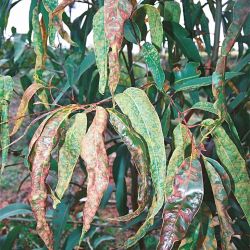Erinose mites

Blistering in spotted gum leaves caused by erinose mite
© Queensland Government

Leaf blisters caused by erinose mite
© NSW DPI
Erinose mites are microscopic invertebrates that feed on plant tissue, and cause distortion and abnormal growth in shoots and leaves. They cause damage in young spotted gum plantations.
Scientific name
Rhombacus spp., Acalox spp.
Description
- Mites are too small to be seen by the naked eye or with a hand lens. They are identified by raised, yellow to red blisters on leaf surfaces, covering the whole leaf in severe cases.
- See high-resolution images of erinose mites.
Distribution
- South-eastern Queensland
- Central Queensland
- Northern New South Wales
Hosts
- Spotted gums (Corymbia citriodora subsp. citriodora, C. citriodora subsp. variegata, C. maculata)
- Less common on C. henryi and Corymbia hybrids
- Queensland oak (Corymbia citriodora subsp. variegata x C. torelliana)
- Prevalent in 2–3 year old plantations.
- Different provenances (origins) of Corymbia vary with respect to tolerance. Woondum provenance is one of the most susceptible and northern New South Wales provenances appear to be less susceptible.
Damage
- Large swarms of mites cause raised yellow to red raised blisters on the leaf surface. In severe cases blisters cover the entire leaf surface.
- Blisters reduce efficient photosynthesis and affect tree growth when leaves are retained over long periods.
- Severe defoliation can occur when heavily infested leaves are shed prematurely.
- Shoot distortion can cause the tree to lack a clear central stem (apical dominance).
Resources and research
- Carnegie, AJ, Lawson, SA, Smith, TE, Pegg, GS, Stone, C, McDonald, JM. 2008, Healthy hardwoods: a field guide to pests, diseases and nutritional disorders in subtropical hardwoods. Forest & Wood Products Australia, Victoria.